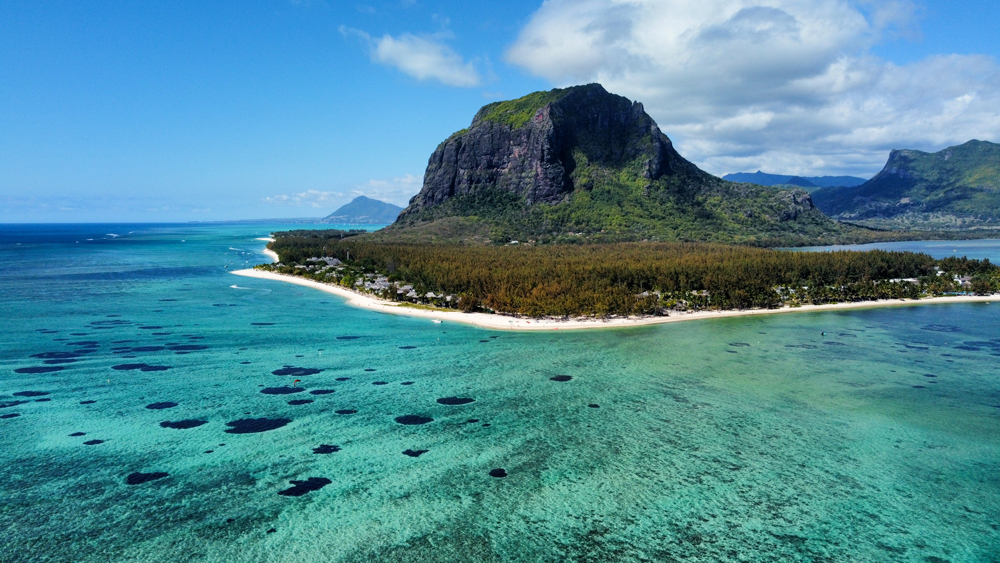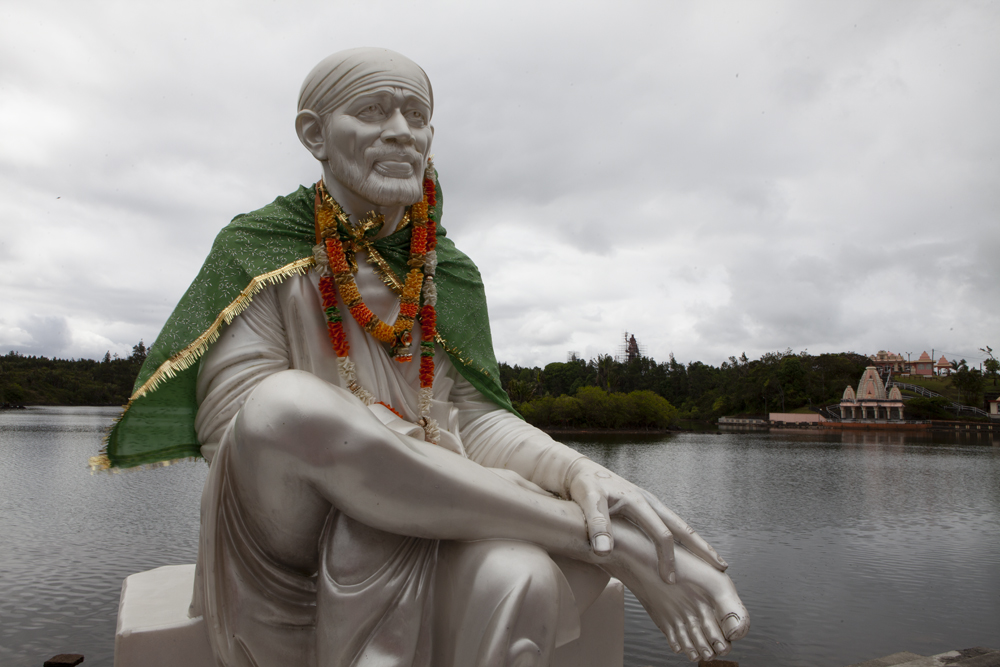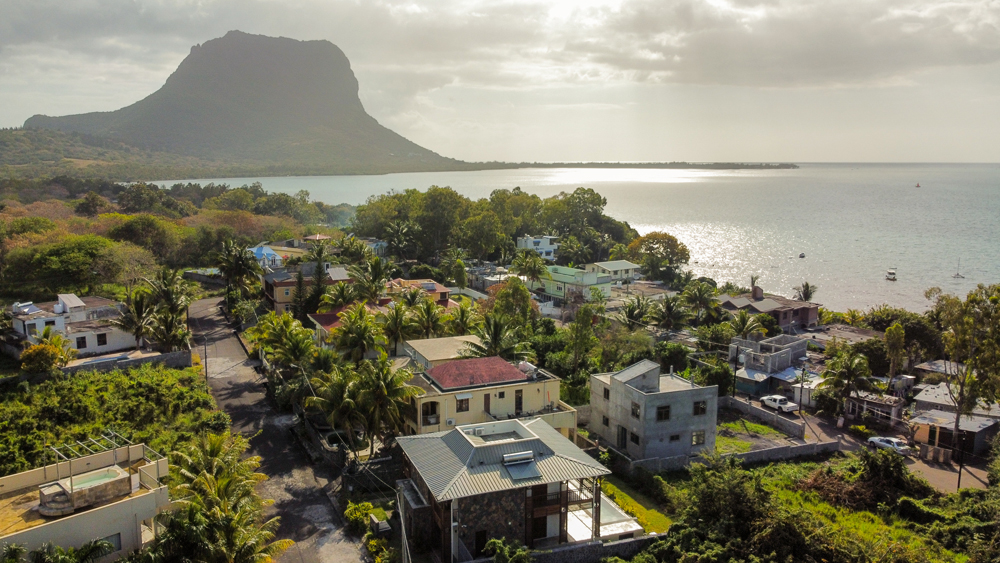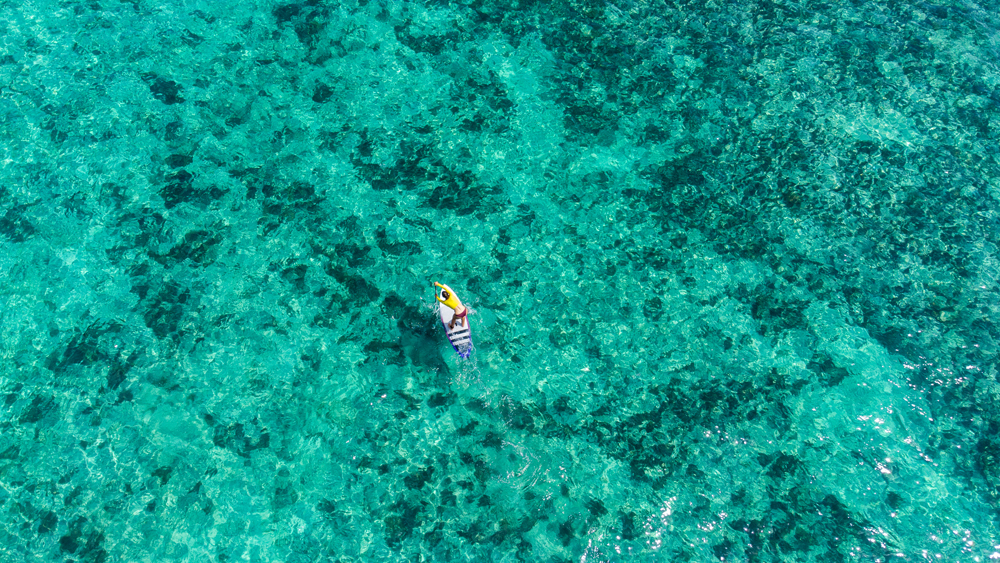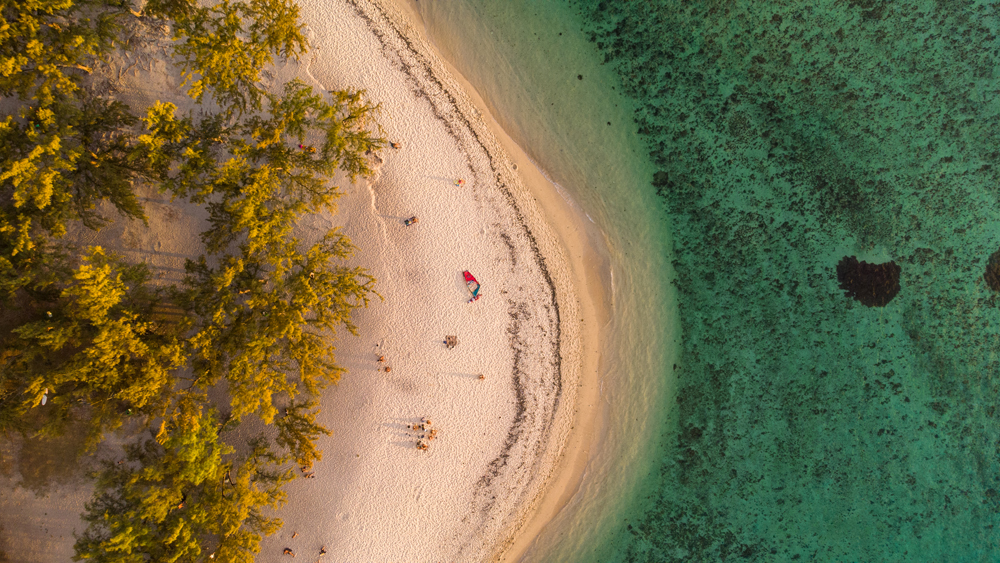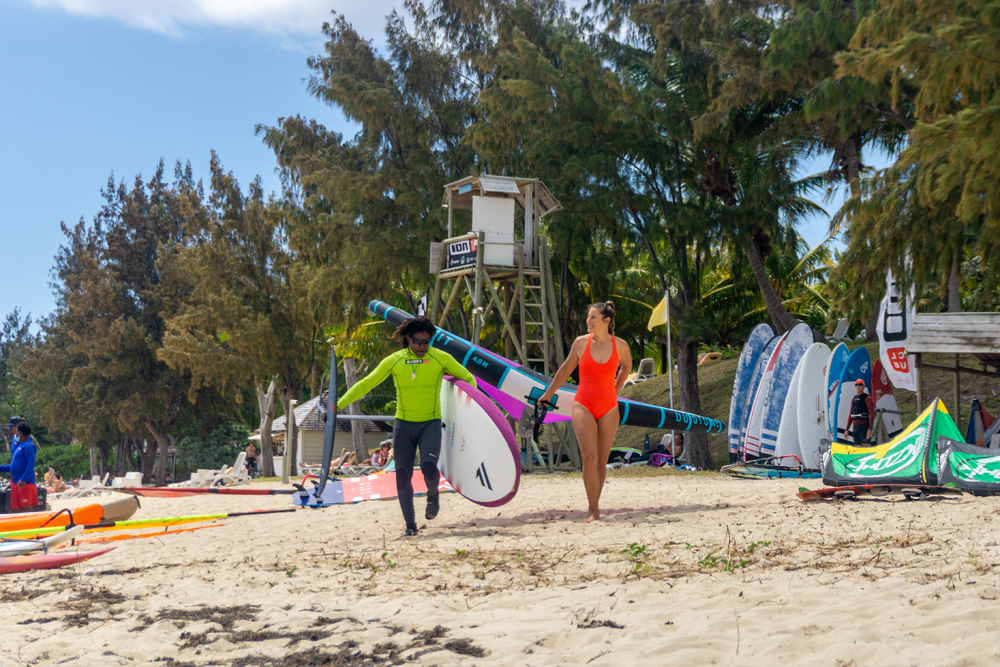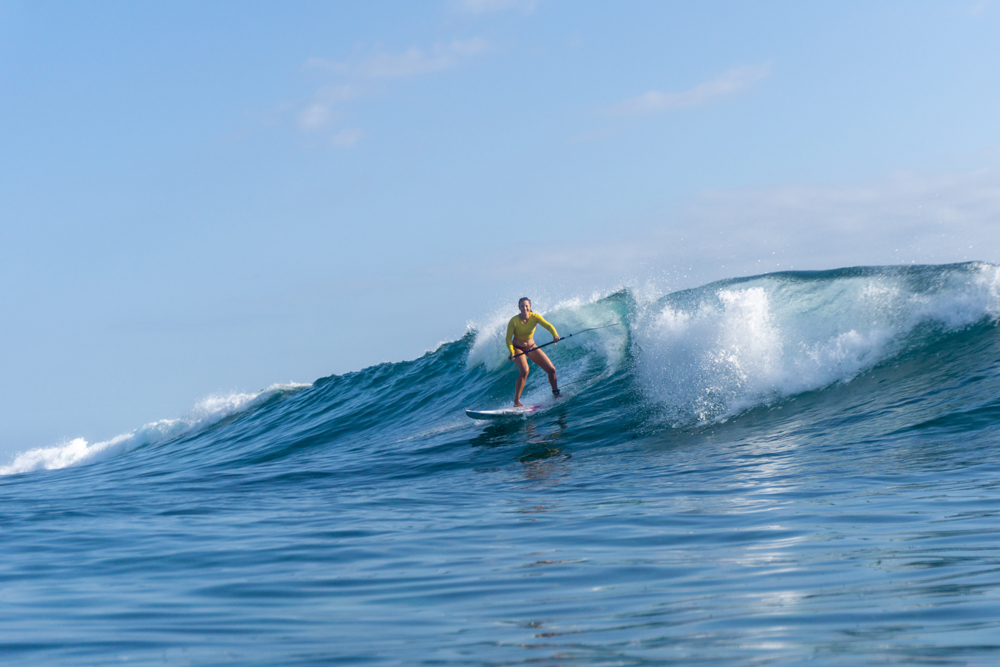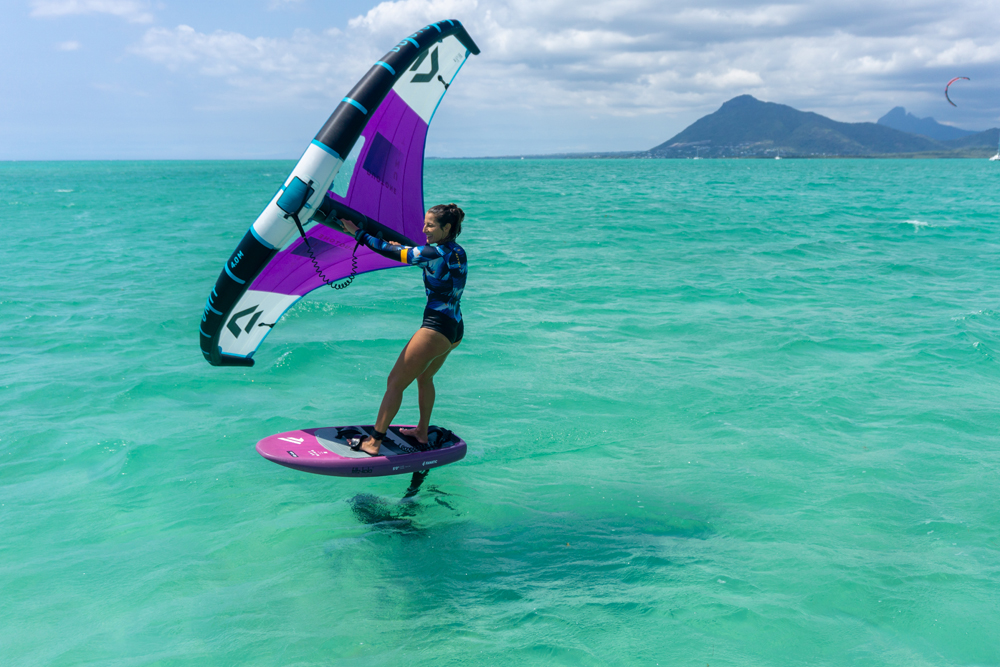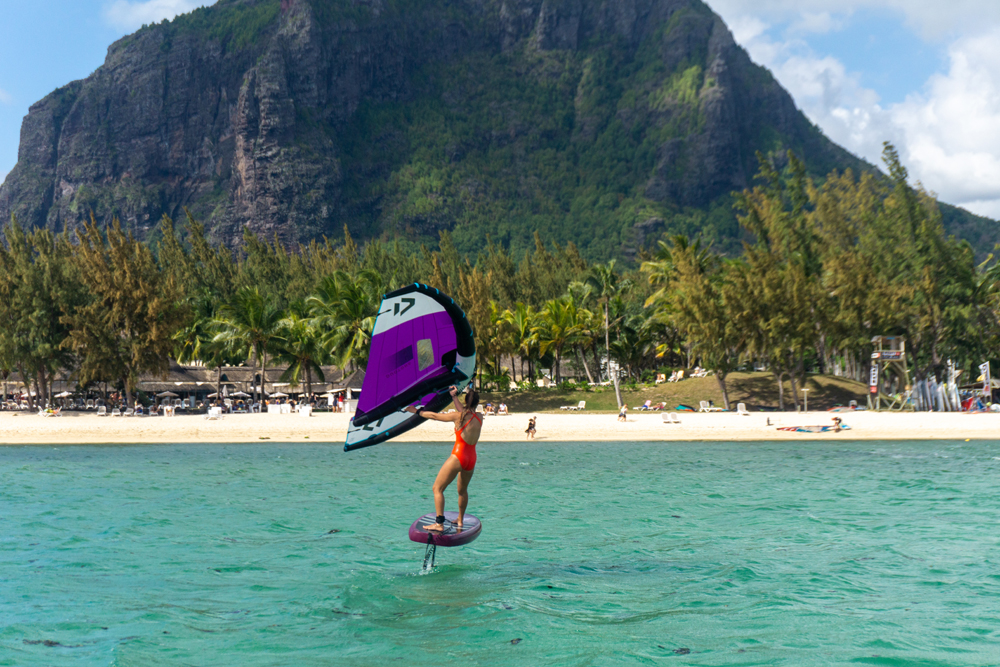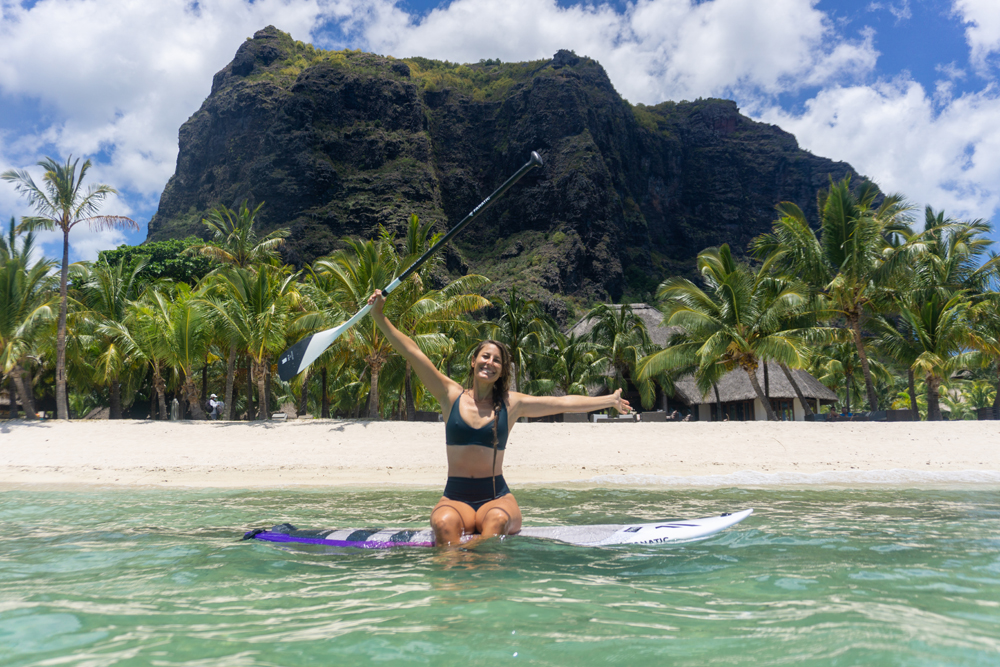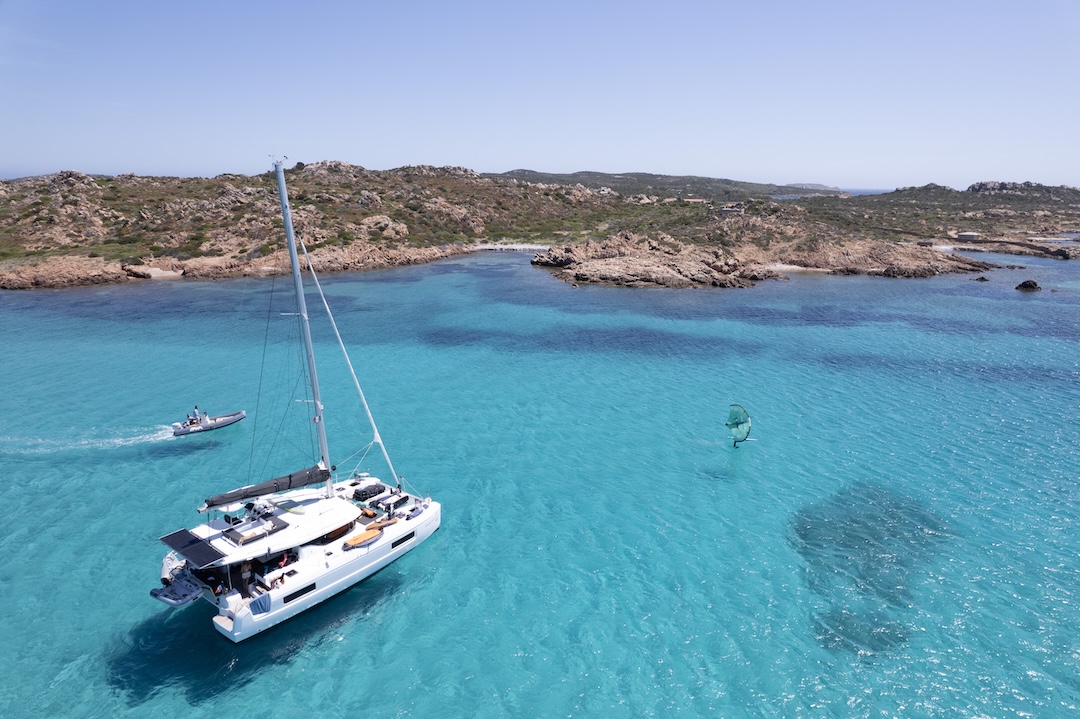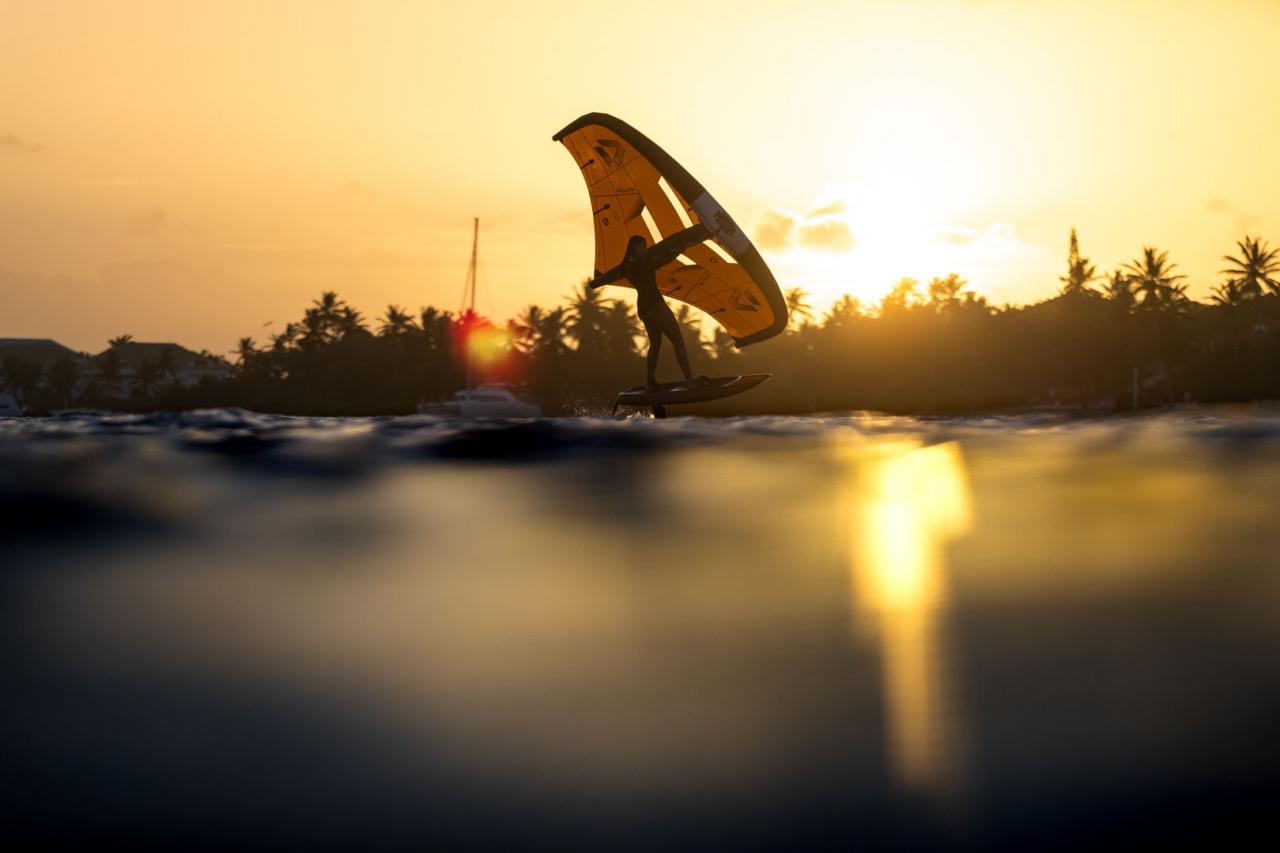Mention the island name of Mauritius and thoughts go to coconut palms overhanging pristine white sand beaches embraced by frolicking honeymooners. For surfers, the same name is immediately associated with the famous "Tamarin", “One-Eye” or "Manawa" waves, expert-only reef breaks that are featured on the covers of sports magazines. Yet, Mauritius is much, much more than waves and honeymooners. These coral reefs transform the ocean swells into some of the best waves in the world, while also creating bucolic shimmering lagoons in crystalline waters, a stand up paddling paradise that paddlers can enjoy with the entire family no matter what their ability level. Wait for the wind to come up mid-day and you can experience the goods by diving into windsurfing, kiting or wingfoiling. This island paradise offers multiple options for the entire family to spend time together on the water while giving more advanced water athletes something to cut their teeth on (no pun intended) in the world class breaks that surround the island.
The Mauritius nation’s cultural diversity translates into an extensive range of experiences, textures, and flavors. This island paradise offers a true waterlover’s experience to explore both on and off the water, including the opportunities of paddling with dolphins, swimming under waterfalls, and getting to know the thousands of endemic species of hibiscus, orchids, and colorful birds (it is, after all, the home of the now-extinct famous Dodo bird) on some of the most beautiful hikes in the world. This island nation is truly an outdoor paradise that will leave travelers tanned, smiling, and recharged after having levitated across these crystal clear waters. Welcome to Mauritius!
History: Emerging from a Dark Past, Mauritius Now a Pearl
Located in the Indian Ocean, the island nation of Mauritius neighbors the French island of Reunion, to the east of Madagascar. It sits about 2,000 kilometers off the southeast coast of the African continent. The Republic of Mauritius, as it is officially called, includes the islands of Mauritius and Rodigues along with the outer islands.
This idyllic paradise was originally discovered as a convenient stopping off point along the trade routes from Europe to Asia - a position that has left a painful past, which today translates into its cultural diversity. First discovered by Arab sailors and later Portuguese traders, the island was originally colonized by the Dutch, who bestowed upon the island its name. After the Dutch, the French converted the island into a strategic port for maritime commerce, and it became an important port in the slave trade, with enslaved people being originally brought in from Africa, and later cheap labor being imported from India. At one point, 80% of the island’s inhabitants were enslaved laborers or their descendants. Eventually the island was transferred into the hands of the British, who in time abolished slavery, and the country of Mauritius proclaimed its independence in 1968.
The peninsula on the southwestern tip of the island, featuring the imposing Le Morne Brabant Mountain, is today a renowned backdrop for this world watersports paradise. This same peninusla also constitutes a symbol of the resistance to slavery with the abrupt geography serving as a refuge for many individuals escaping from involuntary servitude. On the day slavery was abolished, armed officers climbed the mountain to notify the escaped individuals of their freedom, but in a grave misunderstanding, the formerly enslaved people chose to plunge to their deaths from Le Morne’s steep cliffs as the ultimate act of resistance to being recaptured. It was a tragic end to a dark moment in the country’s history.
With a storied history and cultural influences from so many far-flung parts of the world, Mauritius today is a juxtaposition of colors and flavors that coexist in one of the most peaceful countries of the world, offering a true taste of exoticism to visitors from all over.
Santosha, White Shorts and Localism
Surfing first arrived to Mauritius’s coasts in 1962, at the hands of Joel Rosnay, a Mauritian who discovered surfing in France. Then surfboards began arriving from South Africa and Australia, and locals joined in to ride the waves of Tamarin. In 1974, the famed surf movie “The Forgotten Island of Santosha” was filmed here. Once it was revealed that Santosha was really the island of Mauritius, the surf world congregated on the perfect reef breaks that surround the island. It is said that this inundation of surf tourism led to the explosion of extreme "wave protectors", with the infamous “White Shorts” surf gang (with people from all over the world who had settled in Mauritius) protecting their "local" breaks.
Think Outside the Swell: Paddle the Inside Lagoon
Today, surfing, kitesurfing and windsurfing are major attractions at various parts of the island. Not hard to believe once you’ve viewed Mauritius’s crystal clear waters, tropical temperatures, and postcard perfect beaches. All of these are the perfect setting for any type of water sport. While Mauritius is, perhaps, best known for world class breaks for surfers, such as the famed Tamarin, One-Eye and the moving mountains of Manawa, often forgotten are the shallow, interior lagoons formed by these same famous waves. The coral reefs that transform the ocean’s swells into a surfer’s dream also protect the lagoons from the wild energy of the ocean, thus creating a shallow, flatwater playground ideal for stand up paddlers who enjoy the abundance of shimmering, turquoise waters.
The shallow waters of the lagoons make it a joy for the entire family to explore the coastline, whether it’s paddling along the white sand beaches, snorkeling the inner coral reefs, or simply enjoying the warmth of the island’s tropical waters. Mornings, the waters are quiet and glassy, perfect for enjoying stand up paddle touring and gentle surf. Once the trade winds pick up in the late morning, the island transforms into a windsurf, wing and kitesurf paradise. If you practice any of these sports, you will find yourself flying above some of the clearest water ever seen, with explosions of colorful coral heads passing underneath your feet. You can dip your hand into the water to feel the speed between your fingers, skimming across the surface above the famed Mauritius “Underwater Waterfall”. If you have never tried any wind sport, this setting might offer an excellent opportunity to learn something new. The majestic coastline is hypnotizing in its lush vegetation and dramatic mountains, and the warm, tropical air invites vacationers to spend hours flitting across these natural pools.
Waterlover #1: Stand Up Paddling around Mauritius
Arriving in Mauritius with a focus on stand up paddling and exploration, many spots around the island open up to waterlovers to enjoy the endless kilometers of protected lagoons. Even though Le Morne is the main water sports center, there are ample vistas to explore within the beautiful locations scattered around the island. Here are a few:
Le Morne:
The main watersports scene of Mauritius is based in Le Morne on the southwestern tip of the island. The beauty of Le Morne dwells among the shadows of the majestic Le Morne Brabant Mountain. If you are looking for a watersports family holiday, this is a perfect location to set up a home base. Le Morne is the most popular area because if you are into surfing, you can paddle to three surf spots from this beach including Manawa, One Eye (for experts) or Little Reef (for beginners/intermediates). Also from Le Morne, you can take a "water taxi" to go to other convenient surf breaks nearby, as well as additional watersports schools and rentals to learn or practice any watersport. The lagoon here is very wide and safe for family paddling on the pristine waters and for viewing the beautiful Le Morne Brabant Mountain from a fresh perspective.In Le Morne the lush vegetation, accentuated by the sharp escarpments of the mountain, provides a stunning backdrop, together with palm-lined, white sand beaches as you paddle along the protected waters of the lagoon. The green and turquoise hues mix below your board as you paddle above the famed Underwater Waterfall. This phenomenon occurs in the turquoise lagoon whose clarity allows viewers to see the sand and silt sediments in perpetual movement, added to by the steep drop off to 4000 meters that creates the illusion of water ‘falling’ beneath your feet. There is a reason this area is the focal point of watersports on Mauritius, not only for its natural beauty, but for the consistency and variety of conditions it offers as well.
If looking for water sport lessons, the Ion Club offers plenty of SUP, windsurf, kite or wing-foiling gear with excellent instructors. The wind gently picks up throughout the morning, so it is a beginners paradise in the light breeze earlier in the day.
Pointe D’Esny:
Located in the southeast of the island, close to the airport, rests a pristine lagoon with plenty of colorful coral to paddle over in high tide. Locals call it "The Pool". This lagoon is wide and pristine, and is also a perfect spot for wind sports. Here you will find the Specialized Kiteboarding School, offering all kinds of foiling lessons, as well as an amazing 25km downwinder excursion all the way to Ile Aux Cerf. This is a truly magnificent experience. Also at Pointe D’Esny, there is a beautiful hotel, Preskil Island Resort, located right on the spot.Ile aux Benitiers: This is an island right out in front of the village of La Gaulette, nearby Le Morne. Visiting the island and the famous Crystal Rock is a must-do for any visitors exploring Mauritius. And there is no better way than doing so on a stand up paddleboard! The lagoon here is deeper than most others in the area, so there is no worry about touching the bottom with your fin. It is even deep enough for foiling sports, if you are into wind sports. Right by the Ile aux Benitiers, you will find the picturesque Crystal Rock!
Anse La Raie:
On the northern tip of the island, Anse La Raie is a great alternative when staying at one of the hotels on the north side of the island. An outer reef is located 2.5 km away, creating a large, protected lagoon perfect for exploring via SUP. It is a very safe spot, and has small waves on the outer reef for more advanced paddlers. There is an Ion Club right on the spot, which recently reopened after the pandemic, where travelers can find SUP gear to rent. Here you will have a slightly different experience than in south Mauritius where there are ample opportunities for nightlife in close-by Grand-Baie.Bay of Tamarin:
Within the beauty of Bay of Tamarin, it is common to paddle surrounded by dolphins!Other lagoons to explore: Belle Mare, to the south of Poste Lafayette, also has a massive lagoon with gorgeous waters to explore. Poste Lafayette is a seaside village offering an excellent lagoon at high tide, located along the northeastern shore of Mauritius. This spot doesn’t get crowded, and you’ll have the lagoon to yourself, definitely a change of pace compared to the scene around Le Morne. Bel Ombre is located on the southern shore of the island, just a couple of minutes east of Le Morne. This area has another spacious lagoon and is a fun experience, with some waves further out on the reef. Also in Bel Ombre, travelers can find good quality and affordable hotels directly on the lagoon. Some other nice places to visit are Trou d’eau douce, Ile aux Cerfs, Grand Rivière, Blue Bay, Flic en Flac Grand Baie and Pereybere.
Waterlover #2: Chasing Waves Around Mauritius
If you are excited to surf Mauritius, the South Hemisphere winter from May to October is the best. This is when it gets more reliable and has consistent groundswells from the southern ocean, but this spot also gets windy in late morning. If you want to also practice additional wind sports and just surf in the mornings before the wind, then this spot will be just perfect!
The swells are not always consistent in Mauritius. Some breaks are only accessible by boat and other peaks are not an option to a visitor. It is best to visit the island with an open mindset and enjoy the surf when it's good, and to embrace the other incredible water-based activities that this island paradise has to offer. Additional treats include stand up paddling through amazing lagoons and over colorful reefs, snorkeling among the coral, hiking to the waterfalls, paddling with dolphins, swimming with whales, savoring the delicious food, learning to wing or just enjoying the beautiful landscape with your family.
A few of the main surf spots are:
Le Morne - Little reef:
is a beginner/ intermediate-friendly, right-hand break inside the lagoon. It works for all kinds of boards and levels of expertise. La Morne can be very crowded, but still has good vibes flowing around. Surfers and SUP surfers can paddle to the spot from the beach.Le Morne - Manawa:
This is a fun, forgiving wave when smaller, with a nice large channel to safely paddle back out. But once the swell picks up, it is a different story. Located over 1.5 km offshore, this spot may allow you to discover the wave of your life as Manawa turns into a mountainous waterpark, but beware the strong currents pulling you out through the channel as the water from the breaking swell rushes back out to the open sea. Even though you can paddle to Manawa from the beach, the strong currents will make it very difficult to paddle back in. The safest way to surf Manawa is to hire a boat to stay with you or to take you out and pick you up.Le Morne - One Eye:
One Eye is a very fast and hollow left-handed break for surf experts only. It is a powerful wave that doesn’t permit mistakes, breaking onto an extremely shallow, sometimes dry, coral reef. One Eye can get crowded and the locals will want some space especially on the weekends. Beware. This break is best left to the truly experienced and committed, but travelers can safely watch from the protected waters inside the lagoon. At One Eye channel there is also a right-hander that is often less crowded. On that side, surfers can paddle out from the beach.Close to Le Morne – by Boat:
Accessible by boat you can surf great waves at Anchor or Ambulate. Each of these breaks are less crowded than the others around Le Morne. Both are also accessible by paddling from the coast. Great for beginner and intermediate surfing!Tamarin Bay– The famous Tamarin Dal
is a dream wave. It is a very shallow barreling left-hander. Unfortunately it is not an option for SUP surfing. It needs a big southwest swell, and when that happens, it can get very crowded. Be aware there is very strong localism protecting this break from visitors and SUP surfers. There are two other breaks in Tamarin: (1) the Tamarin Public Beach is an easy beach break on a southwest or southeast swell, and on the other side of the bay you'll find (2) Black Stone which has a nice right-hander wave.Other known spots are Ilot Sancho, Trou d'eau Douce, Blue Bay, Soullac, Darne, Harbour Riviere Noir. I would recommend you always read or ask about each break before paddling out on your SUP or surfboard to any surf spot. Remember there is strong localism protecting some breaks on Mauritius.
Bringing Your Own vs. Renting Gear on Mauritius
Traveling with your own gear or renting it on the island depends whether your trip will be dedicated to mainly surfing, stand up paddling, wing foiling or you plan on having a holiday visiting the island and may paddle out a few times. If you are "addicted to ride", I recommend bringing your own board. There are a number of airlines flying to Mauritius that allow you to bring a surf, foil or paddleboard for reasonable prices, but be sure to check the updated fees before flying.
Or are you planning to have a relaxing vacation doing various activities as you explore the island and only want to engage in watersports a few times? Rent your board on the island. Be sure to contact the rental centers before you travel to check availability or make a reservation. There is an Ion Club in the South at Le Morne and another one in the North at Anse La Raie, where you'll find equipment ready to go. The rental service includes a safety rescue boat in case anything goes wrong. Si-On.com also offers paddleboards to rent.
Water Tips for Travelers:
SAFETY:
When surfing on the reefs of Manawa or One-Eye, keep in mind that the ION safety rescue boat service ends at 5PM. This is important. Even if cruising inside the lagoons, it is a good habit to get off the water when the rescue service ends, as on big days the currents can pull paddlers out through the channels into the open ocean. The safety boat is included for all ION Club Customers.SURF SHOPS:
Travelers who need any spares or accessories can find everything at the Tou Korek Surf Shop in La Gaulette. If you aren’t staying in La Gaulette, Kitesurf.mu also offers free delivery across the island.WETSUITS:
From November to April, the Mauritian summer months, travelers don’t need a wetsuit as the water really warms up. From April to November you may want to bring a shorty or at least a neoprene top as evening sessions can be a little chilly. I would recommend always packing a long-sleeve lycra as well, to protect your skin from the sun during longer sessions.ABILITY LEVEL:
The beauty of Mauritius is that surfers, kite boarders, wing foilers, windsurfers and paddlers of all levels can enjoy the waters around the island from complete beginner to expert. And best of all, at places like Le Morne you can all launch together from the same beach.WATERSPORTS SCHOOLS:
Le Morne: Ion Club, Ion Club St. Regis, Pryde Club Mauritius, Si-On.com. Pointe d’Esny: Specialised Kiteboarding. Anse La Raie: Ion Club Anse La Raie.Beyond the Swells & Lagoons: What to do on Mauritius
For the non-swell, windy days, there are plenty of activities to explore the island that the entire family can enjoy.
Boat Trips and Whale Watching:
Explore the country from the water on a boat trip and snorkel the crystalline clear waters around Crystal Rock. Paddle with dolphins close to Tamarin Bay, or spot majestic mammals on a whale watching tour. There is a local kitesurfer and wing-foiler to be found at One-Eye who’s name is Bart (find him on Instagram at @mauritius_with_bart). Bart is a great guide for all these activities both on and off the water for the entire family to enjoy. Travelers can also catch a boat to surf the outer reefs, or simply to get close and watch the surfers do their thing.Hikes and Waterfalls:
Black River Gorges National Park is a magnificent landscape with plenty of scenic hikes. You will see waterfalls and endemic plants, rare orchids, and beautiful tropical birds. Hike the seven waterfalls, visit the Tamarind Falls, or visit the Seven Coloured Earths in Chamarel for a truly unique experience. For windsurfers, hiking up the 556m Le Morne Brabant is a must-do hike that will offer breathtaking views of the turquoise lagoons you will be windsurfing later in the day, and watch the perfectly peeling waves breaking on the outer reefs of Manawa and One-Eye. We recommend going with a guide. @vixvipservices can help you organize your adventures.Port Louis:
Founded in 1735 by the French colonists, Port Louis boasts a rich, multicultural element with strong Indian, Japanese, African, and European influence. The central market and the Port Louis bazaar are most attractive where shoppers can lose themselves among the tropical fruit and spices. Once in the capital, be sure to also visit China Town to try the excellent food or to visit the curious modern pharmacies that will also sell you traditional Chinese herbs and medicines.Float-Plane Sightseeing:
Taking off just a couple of kilometers from Le Morne, you’ll enjoy a spectacular view from above Manawa and One-Eye, descending almost down to sea level for a truly unique experience. You’ll also get the opportunity to spot the famous Underwater Waterfall as the currents around Le Morne pull the sand into a one-of-kind display that can only be observed from the sky.Temples, Markets, and Villages:
The Triolet Shivala Hindu Temple, and the Market Flacq, a beautiful and colorful open air market, are must-do visits while in Mauritius. The Dutch Ruins, one of the first Dutch fortifications in Vieux Grand Port, is one of the oldest settlements on the island. If visiting Pointe d’Esny, be sure to also visit the wonderful market at Grand Port Bay in Mahebourg, where visitors get a real feel for the true Mauritius unencumbered by outside influence.Local Food:
The country's multicultural mix makes for a truly spectacular culinary experience including Hindu, Arabic, Creole, French, and Chinese influences. You can just imagine the delicacies to be experienced, whether it be a humble food-stand on the side of the road or an exclusive, high-end restaurant. Even in the supermarket travelers are sure to find a range of exotic ingredients to spice up your cooking. Of course, don’t forget to try the local Phoenix beer and the famous vanilla-scented Chamarel rum!Beach Barbecues:
Once the weekend rolls along, be prepared to experience a different scene when arriving on the beach. The beaches and parks along the coast fill with music and good vibes as locals make their way to the water to share laughs, food, and good cheer throughout the weekend. You can feel the good vibes and harmony as Hindus, Muslims, Creoles, and tourists all share and enjoy the treasures of the beach and beautiful sunsets that Mauritius offers.A Few Travel Tips:
ACCOMODATIONS:
If you plan on basing yourself around the Le Morne area, you will have the choice between staying right at Le Morne in an all-inclusive hotel, or at hotels, villas, or rental houses in the outlying villages of Le Morne or La Gaulette.Located a couple of minutes drive from the windsurf spot, the village of La Gaulette has everything travelers need including a supermarket, restaurants, surfshop, sail repair, and more. To rent an apartment or villa, search on “ to find rentals from local surfers who will be happy to share local tips and advice with you, and maybe even join you on the water for a session. You can also find plenty of apartments on rental apps, or get in touch with Tom and Verena at Si-On.com for multiple services for windsurfing vacations on Mauritius, including accommodations, car rental, and gear rental.
WHAT/WHERE TO EAT:
Mauritius offers a great diversity of cuisine with a unique fusion influenced from its multicultural past, together with fresh fish and tropical fruit. I would recommend getting adventurous and exploring, both the street food as well as the restaurants. At the beach, you will find food trucks serving excellent fish dishes and fruit juices for very reasonable prices, so for refueling between sessions this is a great option. Some surfers have also opened up restaurants in the area featuring local fish and seafood, such as the delicious options at Wapalapam and Enso, as well as the offerings at Ocean Vagabond. Be sure to also explore the multitude of local cuisine options while visiting the island.WHAT TO PACK:
A few essentials to pack include booties, mosquito repellent, sunscreen, shorty wetsuit, lycra, and electric plug converters. But don’t fret, if you forget anything, everything is available and relatively affordable in the supermarkets.AIRPORT TRANSFERS:
Your hotel or vacation rental can organize your airport transfer, or contact Si-On.com when flying with boards.CAR RENTAL:
You can rent a car from the typical car rental companies, but many people who rent you your apartment will also be able to offer a rental car as part of the same package, They have a special license for that as well. This is often much cheaper than a car rental company. You can also contact Si-On.com for car rentals. Mauritius is a safe country, but it is recommended to unpack your gear from your car overnight or to park within a gated driveway.LOCAL CURRENCY:
1 € = 48,5 Rupee MUR. You can exchange money at the airport, or there are ATMs that offer currency exchange at the same rate throughout the country. There are also plenty of ATMs to take out money, and you can pay with a card in most places you go.SIM CARD:
You can pick up a local prepaid SIM card at the supermarket for a very reasonable price. Expect to pay about 10 EUR for 150 GB for 30 days. Be sure to bring your passport, and you can only pay in cash. Operators include My.T and Emtel.LANGUAGE:
Spoken languages in Mauritius include English, French, and Mauritian CreoleYou Will Be Back for More than One Taste of Delicious Mauritius!
Every single moment in Mauritius, I knew I was living one of those trips of my life, and every second in the water I felt lucky and blessed to be there. After one month surrounded by the most stunning landscapes, gliding above turquoise waters, riding the waves, watching the reef passing under my feet, feeling the sun on my skin and the fresh air on my face, tasting all the exotic and tropical flavors and going to bed each night with the biggest of smiles on my face from SUPing and windsurfing, I knew this would be the first of many trips to this amazing island!

